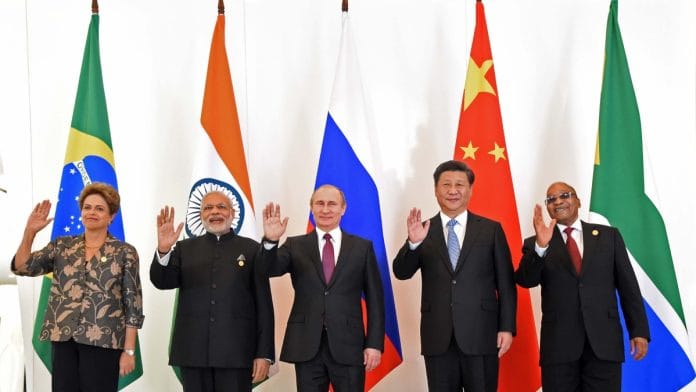Thank you dear subscribers, we are overwhelmed with your response.
Your Turn is a unique section from ThePrint featuring points of view from its subscribers. If you are a subscriber, have a point of view, please send it to us. If not, do subscribe here: https://theprint.in/subscribe/
The contributions of BRICS (Brazil, Russia, India, China, and South Africa) nations to the United States extend beyond economic dimensions and encompass strategic partnerships, innovation ecosystems, and cultural exchanges that benefit both sides and contribute to global prosperity and stability.
The BRICS nations collectively contribute to the United States in various ways:
Trade: BRICS are significant trading partners for the United States. They cater to US exports, ranging from manufactured goods and technology to agricultural products. Conversely, the US imports a variety of goods from them including machinery, electronics, energy products, and raw materials.
Investment: BRICS nations make investments in the US across various sectors, including real estate, technology, manufacturing, and finance. These investments create jobs, spur economic growth, and foster innovation in the US economy.
Capital Flows: BRICS nations, particularly China, are major holders of US Treasury securities and other US financial assets. This helps the US in financing its budget deficits and keep borrowing costs relatively low for American consumers and businesses.
Economic Cooperation: BRICS nations are centres of innovation and research in various fields, including technology, healthcare, and renewable energy. The US and BRICS collaborate in scientific research, academic exchange, and technological development contributing to economic advancement.
Global stability: The BRICS nations cooperate with the US in international forums such as the G20 helps address global challenges, including financial crises, climate change, and public health emergencies.
Diversity and Cultural Exchange: The interactions between the US and the culturally diversified BRICS nations foster cultural exchange and mutual understanding of different cultures.
BRICS nations play significant roles in the global financial system, each contributing in different ways. But lately, Russia invades Ukraine and the US hits them with sanctions and freezes their reserve dollars making it difficult for Russia to have access to their own funds.
The global community was paying close attention to it!
The substantial reserves many countries hold in US dollars make the freezing of financial assets by the US a difficult pill to swallow. Countries, concerned about their economic stability, contemplate de-dollarization as a means to mitigate risks associated with their financial condition.
De-dollarization refers to the reduction in the dominance of the US dollar in international trade and finance. The BRICS nations have formed an alliance to reduce the dependency on the US dollar for settling trades among them. The BRICS nations in their upcoming summit in October, to be held in Russia,
shall have discussions on finalising their BRICS currency known to be backed by a basket of commodities including gold. It will be based on blockchain technology and digital currency open for access to common people.
The GDP of BRICS countries is $30.8tn and the population is 3.3bn people, hence BRICS currency if launched is going make a significant impact on the world. The new currency can be a viable alternative to the US dollar.
Prospects of De-Dollarization for BRICS –
BRICS seek to assert their independence from economic sanctions imposed by the US policies. BRICS desire to have a multipolar world with less US interference in the global financial system, to exhibit their growing economic power. Their economic interests are guarded and typically reduces volatility spillovers to BRICS.
An alternative regional clearing and settlement system to SWIFT would enable transactions to be conducted directly in BRICS currencies, reducing reliance on the US dollar and mitigating currency exchange costs. It will eliminate the need for multiple currency conversions resulting in faster transaction times and lower transaction costs for business stimulating increased trade and investment flows among BRICS countries.
By conducting transactions in local currencies BRICS can enhance the demand of their local currencies, promote their local industries, increase consumption, and foster economic growth. They can tailor their policies and strategies according to their needs and priorities.
Currently, the diverse economic situations, policy agendas, and exchange rate complexities present significant challenges for BRICS countries to coordinate and unite in introducing a new currency as a viable alternative to the US dollar.
Many countries holding significant reserves in US dollars often invest in US Treasury securities. With de-dollarization, reduced demand for these securities may lead to higher interest rates in the US as the government seeks to attract investors. Since the US government relies heavily on borrowing to finance its budget deficits, any increase in interest rates could increase the cost of servicing the national debt, necessitating higher taxes or cuts in government spending. Investor sentiment for the dollar could dampen with its depreciation.
De-dollarization may not necessarily spell disaster for the US, it could lead to significant economic and geopolitical adjustments and respective rebalancing of funds held by central banks.
These pieces are being published as they have been received – they have not been edited/fact-checked by ThePrint


